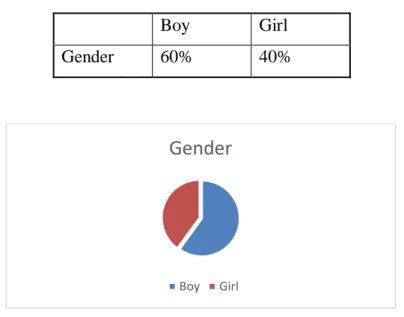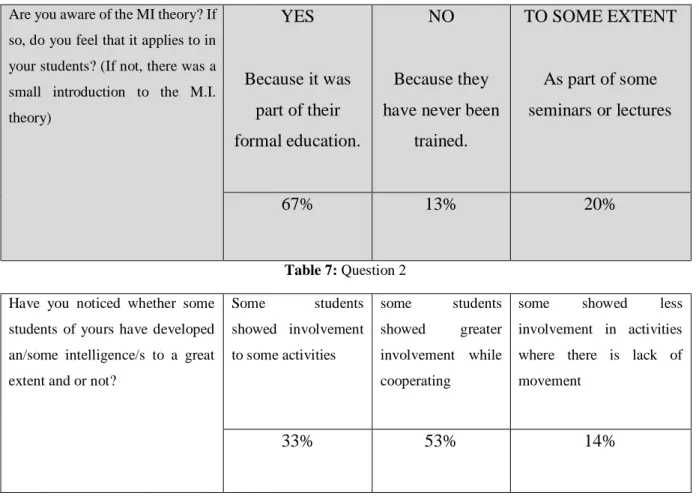Teachers were asked to indicate whether they were familiar with MI theory and whether they observed that some of their students had some or all of the different intelligences and whether they felt the need to differentiate the lesson based on their observations. The data collected in relation to the main questions of the study offer positive signs for individual students' language acquisition progress in this EFL classroom.
Introduction
Definition of Young Learners
Characteristics of Young Learners
However, things improve after the age of eight, when they can tell the difference between fact and fiction, constantly ask questions, consider language and the physical world to make sense, and are able to collaborate and learn from her. others. What is interesting is the fact that students can acquire a foreign language without great difficulty before puberty because they can use the mechanisms that facilitate the acquisition of the first language (Cameron, 2001).
Theories of teaching Young Learners
Young learners can be considered as those who are between 7 and 12 years old or within the concrete operational stage, where they can develop their knowledge of concrete things that they have around them. Piaget supported the idea that children move through these levels and they go from one to the next only if they have successfully completed the previous one.
Theories and principles of teaching English to Young Learners
Studies have shown that there is a link between language acquisition and preferred learning styles (Breen, 2001; Dornyei, 2005).
Conclusions
What is most important is the fact that children's learning styles must be taken into account, and therefore teachers must use activities that facilitate the three main learning styles mentioned earlier. Provided that the teacher combines the theory of MI with the theories of the new students and practices, the benefits for the students will be great.
Introduction
The eight Intelligences
Musical: This intelligence refers to the ability to perceive, distinguish, transform and express musical forms. Intrapersonal: This intelligence refers to self-knowledge and the ability to act on this knowledge, respectively.
Important points of this theory
Describing intelligences in students
Assessing students’ multiple intelligences
This can prove to be extremely useful, especially when teachers struggle to find constructive solutions to students' problems (ibid). Even students themselves, when interviewed or asked, can share what they consider to be their highest developed intelligence.
Restructuring learning and instruction: Learning and teaching through
Parents have the opportunity to watch their child grow and develop under a wide spectrum of circumstances, and they are expected to be able to identify their children's strongest points. Therefore, students should be instructed and aware of their multiple intelligences so that they can develop their individual intelligence and use different ways of learning both in school and in everyday life.
Restructuring Curriculum design: Developing curriculum through multiple
While appropriate analogies can reveal much about the topic at hand, deeper understanding can be achieved by providing explicit instructions, assessing understanding, providing students with sufficient information for their syntheses, as well as using contributing examples that have proven successful. In addition, teachers can combine physical education and fine arts in the curriculum with more traditional academic areas, thereby helping their students develop the full range of their intelligences. In the light of interdisciplinary teaching, teachers are enabled to work on the basis of their own strengths.
Restructuring assessment using alternative assessment: assessing through
Conventional tests and assessment practices do not correspond to the multiple intelligence perspective, as they fail to adequately and appropriately assess the multisensory or interdisciplinary teaching, the theme-based teaching, the projects, the mentorships or apprenticeships (Chen, Gardner , 1997). Numerous ways should be used for students to show what they know through multiple intelligences. Based on the results of the assessment, teachers may find it necessary to re-plan their lesson in terms of the multiple intelligence perspective so that students can improve their understanding of specific content areas.
Multiple Intelligences and Application
In this way, testing is seen as an essential part of the regular teaching and learning process. These profiles can be used as a basis for individualized learning plans and opportunities for developing students' capabilities in both weak and strong areas. More than 3,000 students from different parts of Greece took the test, and a lot of data was collected regarding the learning profile of the Greek student.
Criticism on the theory of multiple intelligences
Finally, one of the strongest criticisms this theory has received is the fact that Gardner has not conducted any research to empirically prove that his "intelligences" exist autonomously in contrast to what most neuroscientists believe (Peariso, 2008 ). This lack of data and research can jeopardize the application of this theory in the classroom. In this perspective, the researcher and teacher tried to measure the intelligence of her young students with the aim of shaping the data into effective pedagogy.
Conclusions about the theory of multiple intelligences
Gardner (1993) himself has long proposed that MI theory is not an educational goal in itself, on the contrary; Educational goals, judgments and values should emerge from discussions between responsible leaders and citizens. The question, however, is how MI theory can help meet these goals. Terms such as "emotional intelligence" and "social intelligence" are now widely used as part of the conventional wisdom (Goleman.
Introduction
Research context of the current study
The current teaching situation and the learners’ profile
The students at A3 find it difficult to keep up with the other two classes in terms of learning regarding the linguistic and communicative expectations of the lesson. There is also access to the internet, which is used by the students as a source for research. There are approximately fifteen students in each classroom, which has enough space for various seating arrangements, the walls are decorated with posters, and there is a friendly and cozy learning environment for the students.
The Research Hypothesis & Questions
These students are divided into three different classes depending on their level of competence in English. If so, do they adapt their lessons to meet the needs and preferences of their students? What types of activities can be included in a lesson so that students can benefit from them?
The Research Instruments
Constructing the questionnaire
The majority of the questions in the questionnaire given to students are behavioral questions, in the sense that students are asked about the frequency with which they use a particular multiple intelligence as a way of coping with schoolwork. Since students do not understand all expressions and vocabulary in English, a version of the questionnaire in Greek was distributed for convenience and practical reasons. As a result, special attention must be paid to the type of information requested, its wording and the types of items included in the questionnaire.
Qualitative research method: interview
Developing the interview
Before the interview, as expected, the researcher informed the participants about the details of the study and assured them of ethical principles, such as anonymity and confidentiality (Britten, 1999). Finally, the participants were thanked for their time spent on the interview and asked if they wanted to add anything else that the researcher had not included. It is also useful for the researcher to take notes and write down observational thoughts and ideas about the interview as this can help in the data analysis process (May, 1991).
Piloting the questionnaire
Conclusion
Introduction
The questionnaire results
70% of them seem to have already developed this ability to a satisfactory level, but not to the greatest extent. In particular, the vast majority of them (80%) have more than two friends, they are willing to help them when they have problems (85%), play with them (80%) and are interested in their feelings (75%). Finally, a significant percentage of them (45%) are self-confident, while others keep a hobby or interest for themselves (50%).

Interview results
Although all of them were aware that their students had their own preferred ways of learning, only a few of them, four, were willing to make changes and adapt their lesson to meet their needs. The minority of teachers, four, who were willing to adapt their lessons to meet their students' needs indicated that their students tended to be more motivated to participate in their lesson and perform better. Of course, they suggested that this presupposes the careful planning of activities that exploit their students' abilities and help them develop "neglected" intelligences.

Conclusion
Introduction
The listening session
However, excluding the use of L1 is sometimes not possible, especially when there is a communication issue between the teacher and the students. It goes without saying that the extensive use of L2 in the language classroom is more beneficial to young learners than the presence of L1 (Dunn, 1983).
Aims and objectives
The teaching process
Pre-listening task
This task aims to prepare the students for the listening activity, and it is important that the teacher is aware of the difficulties that the students may encounter (ibid). If the teacher is able to create the appropriate conversational context, students will benefit in many ways from listening comprehension (Brewster, Ellis & Girald, 1992). The first and most important strategy for students to use is to predict what the topic of the listening activity is about and then carry out the listening activity to check their expectations.
While-listening task
In this light, students will develop and use lots of strategies as well as transfer experiences from their L1 (Zouganeli, 2004). This is to make use of background information to elaborate on the displayed images (ibid). To this end, the pre-listening task effectively prepares the young learners to engage in the listening activity so that they can later move on to the construction and negotiation of meaning.
Post-listening task
In addition, this activity aims to get learners involved in a totally physical reaction and make use of their imagination and stimulate their creativity. During the presentation of their superhero, the learners will not be interrupted for any comments by the teacher, as these corrections can affect their self-confidence in a negative way (Bloor, 1991). However, the teacher is supposed to take notes while her learners are talking and give feedback when the lesson ends or during another session.
The reading session
Aims and objectives
As already mentioned, the teacher, considering that she wants to help her students develop many reading sub-skills while taking into account their multifaceted intelligence, has prepared a lesson that wants to motivate them and at the same time allow them to have fun.
The teaching process
Pre-reading task
While-reading task
Post-reading task
Conclusion
These two teaching sessions aimed to incorporate the characteristics of young learners in accordance with the basic concepts from MI theory and tried to address the needs of the students according to their responses from the conducted study.
Discussion of the findings and implications, Limitations and Suggestions for further
- Discussion of the findings
- The teaching sessions designed
- Limitations of the current research paper
- Suggestions for further research
On the other hand, there are some educators and critics who challenge the practical application of MI theory in the EFL classroom. Regarding the results from the interview, most of the teachers stated that they were aware of the theory of multiple intelligences (the third research question). Applying the theory of multiple intelligences to 21st century teaching and learning environments: A new tool for effective teaching and learning at all levels.
The Questionnaire
Lesson plan 2
Task Sheet 1